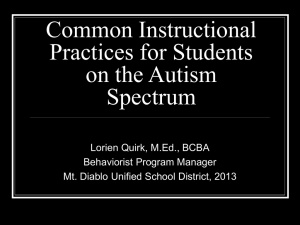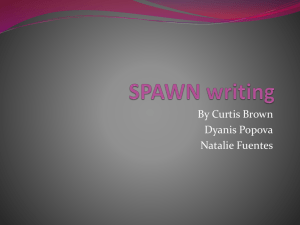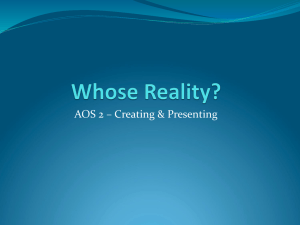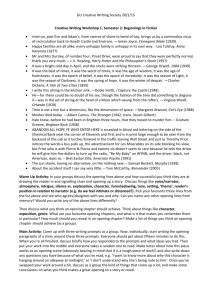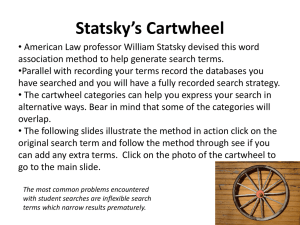Word - VCU Autism Center for Excellence
advertisement
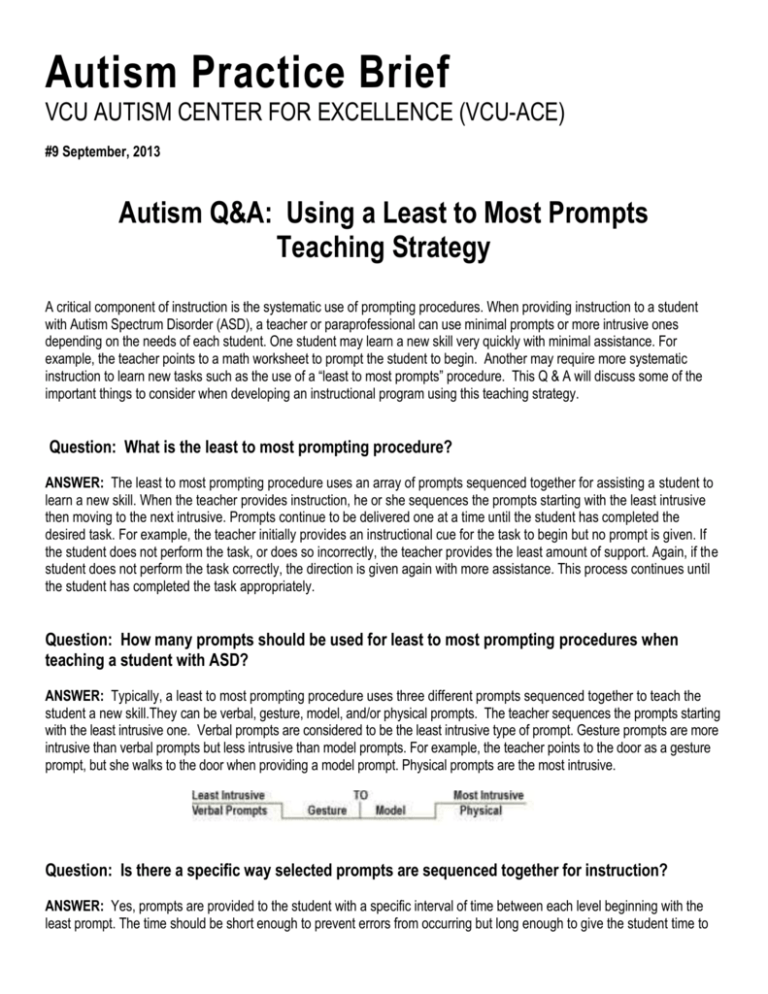
Autism Practice Brief VCU AUTISM CENTER FOR EXCELLENCE (VCU-ACE) #9 September, 2013 Autism Q&A: Using a Least to Most Prompts Teaching Strategy A critical component of instruction is the systematic use of prompting procedures. When providing instruction to a student with Autism Spectrum Disorder (ASD), a teacher or paraprofessional can use minimal prompts or more intrusive ones depending on the needs of each student. One student may learn a new skill very quickly with minimal assistance. For example, the teacher points to a math worksheet to prompt the student to begin. Another may require more systematic instruction to learn new tasks such as the use of a “least to most prompts” procedure. This Q & A will discuss some of the important things to consider when developing an instructional program using this teaching strategy. Question: What is the least to most prompting procedure? ANSWER: The least to most prompting procedure uses an array of prompts sequenced together for assisting a student to learn a new skill. When the teacher provides instruction, he or she sequences the prompts starting with the least intrusive then moving to the next intrusive. Prompts continue to be delivered one at a time until the student has completed the desired task. For example, the teacher initially provides an instructional cue for the task to begin but no prompt is given. If the student does not perform the task, or does so incorrectly, the teacher provides the least amount of support. Again, if the student does not perform the task correctly, the direction is given again with more assistance. This process continues until the student has completed the task appropriately. Question: How many prompts should be used for least to most prompting procedures when teaching a student with ASD? ANSWER: Typically, a least to most prompting procedure uses three different prompts sequenced together to teach the student a new skill.They can be verbal, gesture, model, and/or physical prompts. The teacher sequences the prompts starting with the least intrusive one. Verbal prompts are considered to be the least intrusive type of prompt. Gesture prompts are more intrusive than verbal prompts but less intrusive than model prompts. For example, the teacher points to the door as a gesture prompt, but she walks to the door when providing a model prompt. Physical prompts are the most intrusive. Question: Is there a specific way selected prompts are sequenced together for instruction? ANSWER: Yes, prompts are provided to the student with a specific interval of time between each level beginning with the least prompt. The time should be short enough to prevent errors from occurring but long enough to give the student time to respond correctly. This interval should remain constant during the instruction (e.g., 3, 4, or 5 seconds). The concept is that the student is provided an opportunity to respond to the LEAST amount of assistance possible to complete the task. More assistance is provided only if the student does not respond successfully within the pre-set interval between prompts. For example, the teacher provides a verbal prompt telling the student to “go to your desk.” If the student does not respond within the specified time of 3 seconds, the teacher provides a gesture prompt by pointing to the student’s desk. If the student still does not respond to the gesture prompt within 3 seconds, the teacher provides a physical prompt such as guiding the student to the desk by her elbow. Question: Are there other prompts that can be used in addition to verbal, gesture, model, and physical prompts? ANSWER: Each type of prompt can range from minimal to more intrusive. A verbal prompt can be indirect or direct providing verbal instructions on what the student is to do. An indirect verbal prompt provides a cue that something is expected of the student, but very little information is given such as: “What do you do next?” A direct verbal prompt is more specific and tells the student what is expected. “Pick up the books.” When teaching the student verbal language, the teacher will verbally model what he/she is to say. A verbal model can be partial or full. For example, when teaching a student to say, “I need the bathroom” you can model “I”, “I need”, or “I need the bathroom.” A physical prompt can be partial such as a touch or tap on the elbow. Or, physical prompts also can be total assistance such as hand over hand assistance to complete a task. Question: How does the teacher decide which prompts to use for a specific student? ANSWER: The type of prompt and the level of intensity should be determined by the instructional support needs of each student with ASD. Prompts selected should assist the student in successfully completing the skill being taught. Some students may respond positively to one prompt versus another. In addition, some students with ASD may react negatively to a specific type of prompt. Some students with ASD, for instance, do not respond well to verbal prompts. As an example, Bob’s teacher knows that he does not like to be touched lightly on the arm, as it causes him to pull away. She knows that physical prompts are not effective in assisting him to learn a new skill, but he responds very well to model prompts. If she shows him something to do, he can imitate the response. So, Bob’s “least to most prompts” instructional program includes the use of verbal, gesture, and model prompts. Question: Does the teacher need a task analysis to teach a student with ASD a new skill using a least to most prompting strategy? The answer depends on the skill being taught. Some skills require the student only performs one discrete behavior. An example may be touching “yes” or “no” on a communication device when asked if they would like a drink of water. The teacher could use least to most prompts to teach this skill but not need a task analysis. There really is only one step to the skill being taught. For example, the teacher might offer the cue, “Do you want a drink of water?” If the student does not respond in 3 seconds, the teacher provides a verbal prompt, “Touch yes or touch no.“ If there is no response in 3 seconds to the verbal prompt, the teacher provides a model prompt by pointing to ‘yes’ and ‘no’ on the communication board. Finally, if the student still does not respond, the teacher physically guides the student’s hand to touch either ‘yes’ or ‘no’. However, most activities require the student perform many steps to complete a task successfully. In this case, the teacher will need a task analysis of the steps in the skill. When using a task analysis to teach a skill, the teacher uses the least to most prompt sequence for each step until the skill is completed. It also is important for the teacher to use the same task analysis each time the student receives instruction. Changing the way the task is completed from one trial to the next can prevent the student from learning the skill correctly. These small differences in how the skill is taught can lead to error patterns of performance that are hard to correct once the behavior is learned. Question: Does the teacher need to reinforce the student when using a least to most prompting procedure? ANSWER: In addition to the prompting strategy, the teacher needs to consider how to reinforce the student when he/she responds correctly. Some research states students may learn faster if they are provided verbal praise/feedback once a step is completed. For instance, the teacher might say, “Great picking up your math worksheet” after this step has been done correctly. The student is specifically told what he/she did correctly as soon as the step is completed. Some students with ASD may need a tangible reinforcer when they perform the task correctly. This may include providing reinforcement at various intervals during instruction. Initially, reinforcement may be provided more frequently such as after every step in the task analysis is completed independently. Gradually, the teacher should fade the amount and frequency of the reinforcer so the student needs to perform more of the task before gaining access to the preferred item or activity. Finally, the student should only receive access to the reinforcer at the end of successfully completing the task. Please see the VCU-ACE Autism: Q&A on providing reinforcement for more information on this component of developing an instructional program. Question: Are there other tips for teaching a student with ASD using a least to most prompts strategy? ANSWER: Yes, there are several other considerations when designing an instructional program using a least to most prompt procedure. First and most importantly, the student should not be allowed to make errors during instruction. All errors should be interrupted as soon as they occur with the next level of prompt assistance. For instance, if the teacher realizes the student is beginning to respond incorrectly to a prompt, she should interrupt the error with the next more intrusive prompt in the sequence without waiting the specified time interval. Second, prompts should not be repeated more than once for each discrete behavior or step in the task analysis. In other words, if the student does not respond to a verbal prompt, move immediately to the next prompt in the sequence. Repeating the prompt only provides additional opportunities for the student to make errors. Third, be consistent with the amount of waiting time before providing the next prompts in the least to most sequence. In addition to being consistent with the time that is selected, the teacher should only wait as long as needed to allow the student to respond. If the student is able to physically respond to a prompt within 3 seconds, do not use 5 seconds as the latency period. The intent is to try and teach the skill in the same amount of time that would be needed if the student is completing the skill independently. In other words, the teacher does not want to provide so much time between prompts that the student takes longer to perform the skill than is necessary. Question: How are prompts faded so that the student completes the task without any assistance from the teacher? ANSWER: The system of least to most prompts is designed to naturally fade the amount of assistance provided during instruction. Each trial begins by providing the student an opportunity to respond to the least amount of assistance possible. If the teacher has a reinforcer that is effective for the student, learning should occur as the opportunity to practice the skill is provided. In other words, as the student begins to learn the task, he/she will gradually need lesser amounts of assistance (prompting) to perform correctly until finally the student is independent. The sooner the student responds correctly, the quicker he/she gains access to the preferred reinforcer. If the teaching strategy is successful, the student will begin to perform the task independently with lesser amounts of assistance and eventually with no prompts provided by the teacher. Collecting data on the student’s performance will provide critical information on whether the program is successful and when the student begins to complete the skill independently. SUMMARY There are many different prompting procedures that can be effective in teaching students with ASD new skills. This Autism Q and A has presented some of the important components of writing an instructional program using the “least to most” prompts strategy. Please visit the VCU-ACE website for more information on using prompting procedures for instruction: http://www.vcuautismcenter.org/index.cfm For additional information on ACE go to our website: www.vcuautismcenter.org Contributors for this issue: Katherine Inge, Ph.D., OTR Editor: Becky Boswell, M.B.A. Information for this Frequently Asked Questions (FAQ) is from Virginia Commonwealth University's Autism Center for Excellence (VCUACE), which is funded by the Virginia State Department of Education (Grant # 881-61172-H027A100107). Virginia Commonwealth University is an equal opportunity/affirmative action institution providing access to education and employment without regard to age, race, color, national origin, gender, religion, sexual orientation, veteran's status, political affiliation, or disability. If special accommodations or language translation are needed contact (804) 828-1851 VOICE -- (804) 828-2494 TTY.

